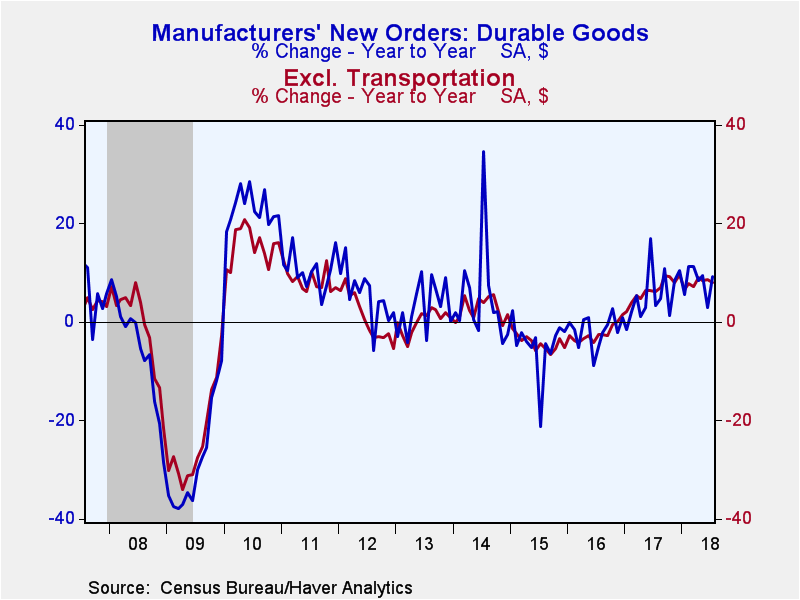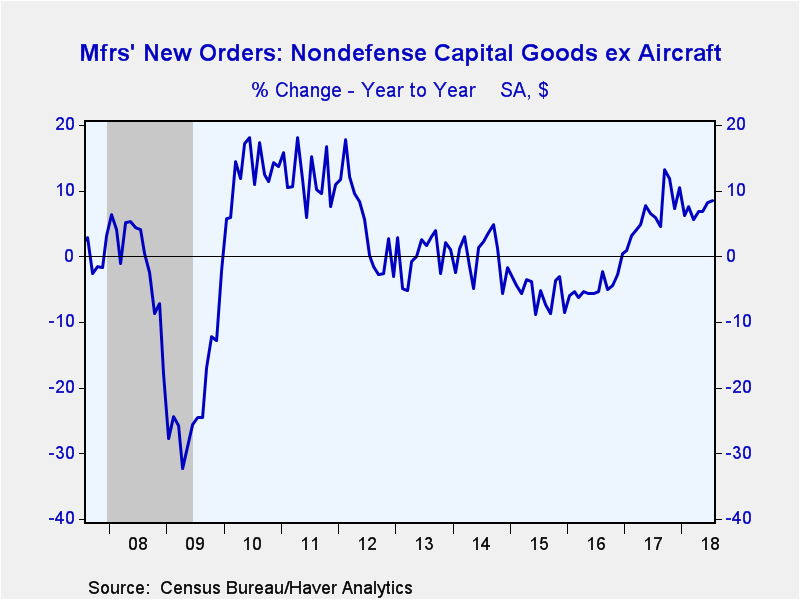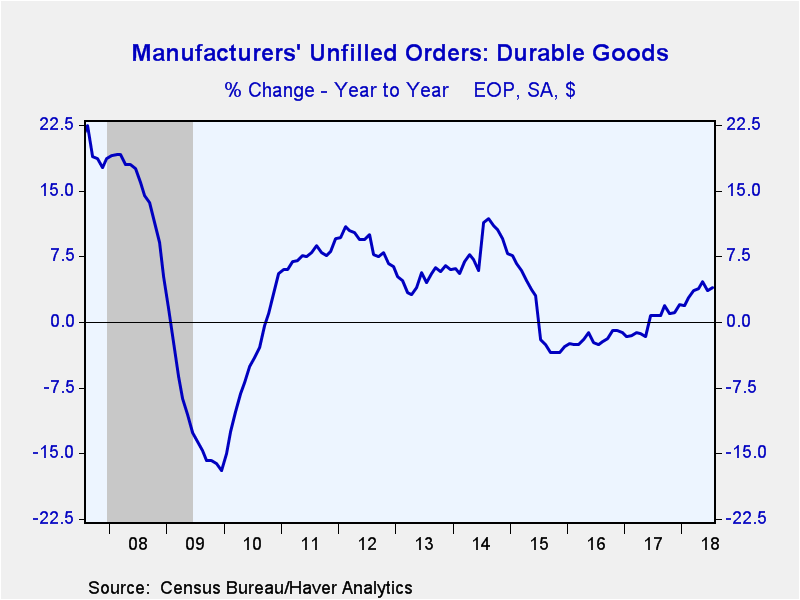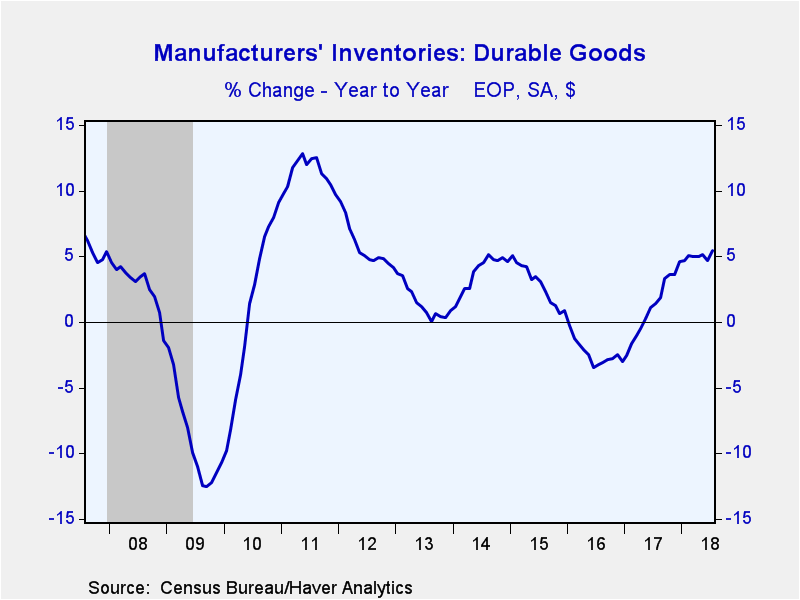 Global| Aug 24 2018
Global| Aug 24 2018U.S. Durable Goods Orders Decline Is Led by Aircraft
by:Tom Moeller
|in:Economy in Brief
Summary
New orders for durable goods fell 1.7% (+9.2% y/y) during July following a 0.7% June increase, revised from 1.0%. An unchanged level of orders had been expected in the Action Economics Forecast Survey. A 5.3% decline (+11.8% y/y) in [...]
New orders for durable goods fell 1.7% (+9.2% y/y) during July following a 0.7% June increase, revised from 1.0%. An unchanged level of orders had been expected in the Action Economics Forecast Survey.
A 5.3% decline (+11.8% y/y) in orders for transportation equipment reflected a roughly one-third drop in civilian aircraft orders. It followed a 6.5% rise. Defense aircraft orders also fell by approximately one-third. A 3.5% gain in motor vehicle & parts orders offset some of these declines.
Orders excluding the transportation sector altogether rose 0.2% (8.0% y/y) in July, about the same as during the prior two months.
Nondefense capital goods orders declined 4.6% (+7.9% y/y), pulled lower by the drop in aircraft bookings. Orders excluding aircraft increased 1.4% (8.5% y/y), the strongest increase in three months.
Leading that strength was a 1.1% rise (8.2% y/y) in orders for computers & electronic products. Orders for computers & related products jumped 12.6% (-8.9% y/y) after declines in four of the prior five months. Communication equipment orders fell 3.2% (+10.3% y/y) after strong gains during Q2. Machinery orders improved 0.6% (5.8% y/y), also after strength in Q2. A 0.2% dip (+9.1% y/y) in orders for electronic equipment, appliances & components came after a 1.4% jump. Orders for primary metals rose 0.3% (17.95 y/y) while fabricated metal orders held steady (8.0% y/y).
Shipments of durable goods eased 0.2% (+7.5% y/y) following a 1.6% jump. Shipments excluding the transportation sector gained 0.6% (8.7% y/y) after two increases of roughly 0.4%. Unfilled durable goods orders held steady (3.9% y/y) following a 0.3% rise. Backlogs excluding transportation rose 0.3% (5.4% y/y) after a 0.6% gain. Inventories of durable goods strengthened 1.3% (5.4% y/y) following little change during June. Excluding the transportation sector, however, inventories rose a modest 0.2% (5.5% y/y), the weakest increase since December 2016.
The durable goods figures are available in Haver's USECON database. The Action Economics consensus forecast figure is in the AS1REPNA database.
Monetary Policy in a Changing Economy is the title of today's speech by Fed Chairman Jerome H. Powell and it can be found here.
| Durable Goods NAICS Classification | Jul | Jun | May | Jul Y/Y | 2017 | 2016 | 2015 |
|---|---|---|---|---|---|---|---|
| New Orders (SA, % chg) | -1.7 | 0.7 | -0.3 | 9.2 | 5.4 | -1.7 | -5.0 |
| Transportation | -5.3 | 1.8 | -1.3 | 11.8 | 3.4 | -0.7 | -6.3 |
| Total Excluding Transportation | 0.2 | 0.1 | 0.3 | 8.0 | 6.5 | -2.3 | -4.2 |
| Nondefense Capital Goods | -4.6 | 2.0 | -2.3 | 7.9 | 9.1 | -5.8 | -11.8 |
| Excluding Aircraft | 1.4 | 0.6 | 0.7 | 8.5 | 6.7 | -4.5 | -5.5 |
| Shipments | -0.2 | 1.6 | 0.2 | 7.5 | 4.0 | -2.4 | -0.8 |
| Unfilled Orders | 0.0 | 0.3 | 0.5 | 3.9 | 2.0 | -1.2 | -2.7 |
| Inventories | 1.3 | -0.0 | 0.3 | 5.4 | 4.6 | -3.0 | 0.9 |
Tom Moeller
AuthorMore in Author Profile »Prior to joining Haver Analytics in 2000, Mr. Moeller worked as the Economist at Chancellor Capital Management from 1985 to 1999. There, he developed comprehensive economic forecasts and interpreted economic data for equity and fixed income portfolio managers. Also at Chancellor, Mr. Moeller worked as an equity analyst and was responsible for researching and rating companies in the economically sensitive automobile and housing industries for investment in Chancellor’s equity portfolio. Prior to joining Chancellor, Mr. Moeller was an Economist at Citibank from 1979 to 1984. He also analyzed pricing behavior in the metals industry for the Council on Wage and Price Stability in Washington, D.C. In 1999, Mr. Moeller received the award for most accurate forecast from the Forecasters' Club of New York. From 1990 to 1992 he was President of the New York Association for Business Economists. Mr. Moeller earned an M.B.A. in Finance from Fordham University, where he graduated in 1987. He holds a Bachelor of Arts in Economics from George Washington University.










